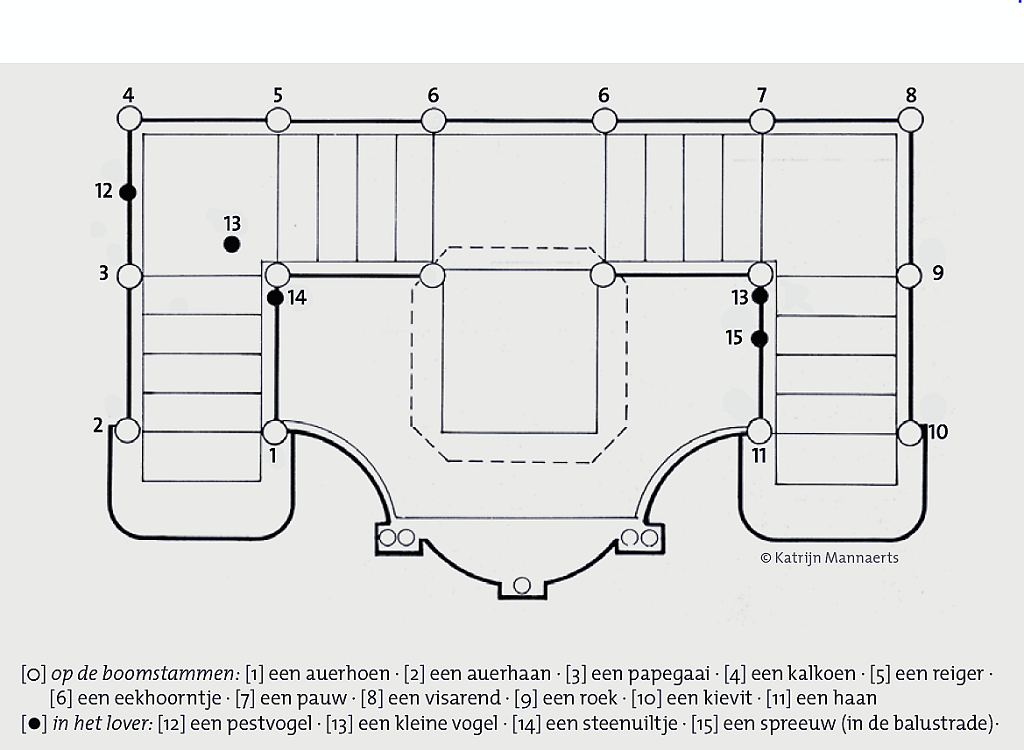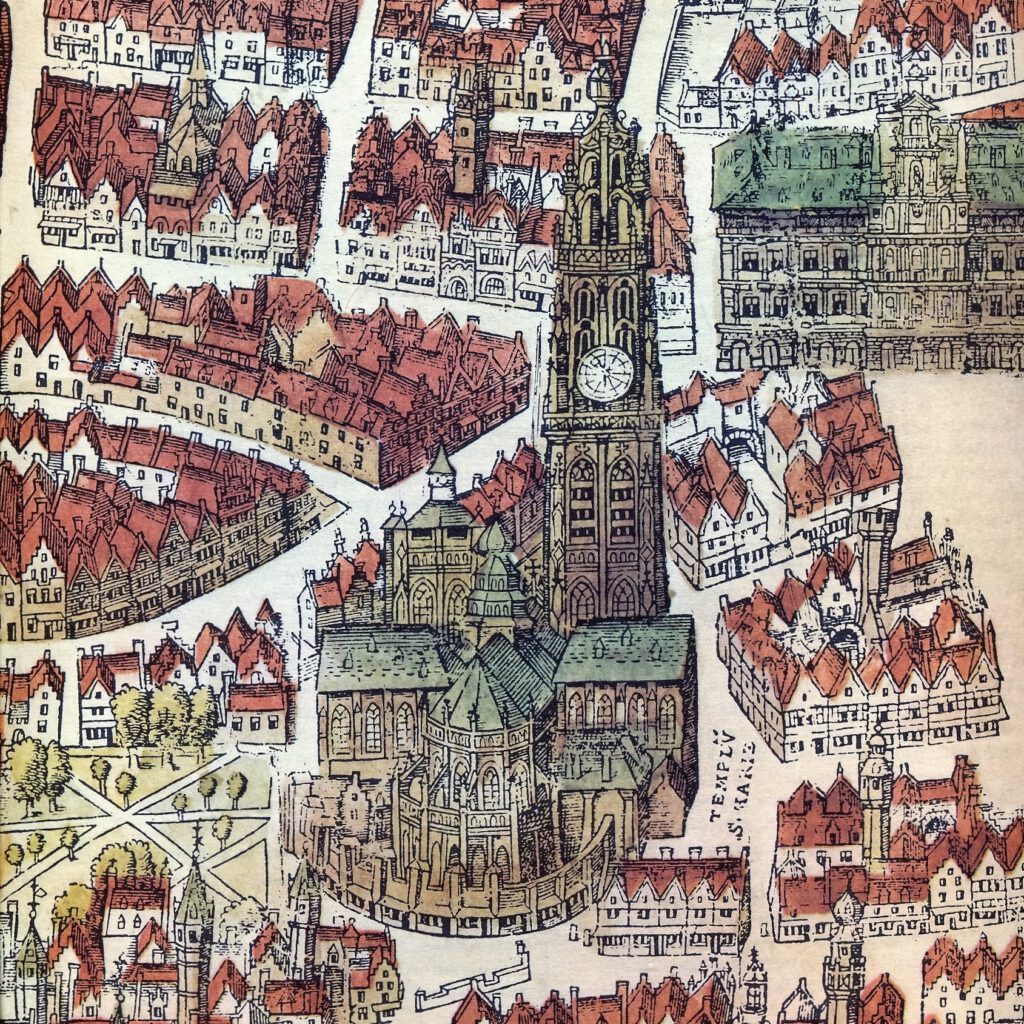The Our Lady’s Cathedral of Antwerp, a revelation.
The pulpit
Until the French Rule the simple Gothic pulpit by Anthonis Wytack (1501) was in the wide southern aisleLengthwise the nave [in exceptional cases also the transept] of the church is divided into aisles. An aisle is the space between two series of pillars or between a series of pillars and the outer wall. Each aisle is divided into bays. of the parish. Not only was the Antwerp Our Lady’s Church renowned for its church music: its preachers were held up as examples for the preachers in England by king Philip II of Spain! On 20th of August 1566 the Calvinist preacherA priest, deacon or lay person who explains the Bible readings during the celebration of Mass. Sometimes a preacher also acts outside of Mass celebrations (and in the past he did so regularly) to clarify certain points of faith and to encourage the churchgoers to a more Christian way of life. Moded jumped on to the pulpit to preach against Catholic ‘idolatry’ and to incite destruction of the statues. For nearly 250 years the piece of furniture showed notches of swords and axes as scars of the Iconoclast Fury, until it was sold by the French in 1798. When the empty church was refurbished in 1803, the pulpit of the Cistercian SaintThis is a title that the Church bestows on a deceased person who has lived a particularly righteous and faithful life. In the Roman Catholic and Orthodox Church, saints may be venerated (not worshipped). Several saints are also martyrs. Bernard’s AbbeyA set of buildings used by monks or nuns. Only Cistercians, Benedictines, Norbertines and Trappists have abbeys. An abbey strives to be self-sufficient. of Hemiksem, a village by the Scheldt south of Antwerp, was acquired. This explains why on the right side of the tub we can admire the bust of Saint Bernard of Clairvaux (1090-1153), who was a very famous preacher himself. The piece of furniture was made by Michiel I van der Voort (1713).
First of all a pulpit has to be functional. The preacher goes up stairs to get on to the platform, from which his voice can reach the audience at a greater distance, and also eye contact becomes possible. The balustrade of the tub must preserve him from falling, especially during an emotional sermon. And finally, to prevent the speaker’s voice from getting lost in the vast space of the church, the sound board above the tub has to direct the sound of his voice horizontally.
The Baroque aesthetic liked shaping everything in a natural, lively way. The first consequence of this is the naturalistic reproduction of nature, which can be felt in knotty tree trunks, supple twigs and juicy foliage, as well as in soft feathers, smooth skin and stylized locks of hair. Further in this monumental piece of furniture the structure of the constructional parts are hidden by a narrative or decorative programme. The platform is not supported by a plain pillar, but by four ‘living’ statues. The columns of the stairs are partly concealed under trees that have been cut halfway, while the balustrade has been transformed into an interlacement of branches, twigs and leaves. The sound board is carried by two strong trees. At least, this is the impression you have, as long as you do not see the metal rod that has been attached to the wall above.
Not only do the preachers on the pulpit propagate a message, the piece of furniture itself contains one, thanks to the surprisingly rich iconographic programme. By sermons the Church wants to proclaim Jesus’s gospelOne of the four books of the Bible that focus on Jesus’s actions and sayings, his death and resurrection. The four evangelists are Matthew, Mark, Luke, and John. ‘Gospel’ is the Old English translation of the Greek evangeleon, which literally means ‘Good News’. This term refers to the core message of these books. to all peoples. In a time when there were hardly any other (printed, broadcasted, digital or social) media, the pulpit was an extremely important means to reach a large audience.

On top of the sound board an angel nearly goes into a dancing nose dive to descend from heaven. Religious content is not regarded as a knowledge merely resulting from human reasoning, but as a ‘re-velation’, literally: ‘something of which the veilHeadgear worn by female religious. Until the Second Vatican Council, all nuns wore wimples, which covered the entire hair and neck. Nowadays, the veil is usually worn on the hair. must be taken away’ to disclose the covered secret. Therefore, at the rim of the sound board a large curtain is lifted up by angels: the ‘re-velation’. The angel on top blows the trumpet. The message must not be kept a secret but has to be trumpeted around. This is an important task of the Church, in this case of the preacher, who neither speaks on his own behalf, nor proclaims his own ideas. His preaching is inspired by the Holy SpiritThe active power of God in people. It inspires people to make God present in the world. Jesus was ‘filled with the Holy Spirit’ and thus showed in his speech and actions what God is like. People who allow the Holy Spirit to work in them also speak and act like God and Jesus at those moments. See also ‘Pentecost’.. This is why the white dove, allegory of the Holy Spirit, is ‘flying’ underneath the sound board.
The Christian message is about Christ, ‘the Word of God’. Consequently, his picture is on the front of the tub. He was not only the man of sensible words, but also of deeds, consistent until death. This explains the crucifix next to the preacher, which faces us with Jesus’s salutary sacrifice of love.
Jesus’s gospel is known thanks to the four evangelists, who each wrote their own version of it. Each is represented by his own symbol: Luke’s bull, John’s eagle, Mathew’s angel and Mark’s lion.

Even though since 1713 the words spoken from this pulpit could only be heard by listeners in the Hemiksem abbey church, and since 1804 by churchgoers in this Antwerp church, theoretically the preaching of the gospel is meant for all mankind. After all the Church received the task to ‘bring about the obedience of faith among all the gentiles’, wherever on Earth. Here the world is traditionally represented by personifications of the four continents that were known then: females, since in original symbolism Earth (in Latin ‘terra’) is feminine. Notice the correct geographic positioning: Europe is in front, which is in the North. Typical of European feeling of superiority (in those times) is the sceptre, symbol of power, in her hand: she rules. To the left, which is the East, is Asia, to be recognized at the rich, exotic clothes and the veil. On the right, which is the West, is America: a native Indian, half naked, with a headdress and a skirt of large feathers. At the Liberation in 1945 an American soldier thought to recognize the popular Indian princess Pocahontas, a predetermined conclusion, which Antwerpians were all too glad to take for truth. In spite of this misinterpretation Lady America does represent Christian missionary work in the New World. In the South a girl with frizzy hair and thick lips acts for entire Africa. Notice how the four continents stand sisterly hand in hand, as they are united by the same Christian belief.

Christ’s solemn assignment Go into the whole world and proclaim the gospel to every creature (Mk. 16:15) is the cause of extra listeners to the sermon, especially birds in the trees. The different species are either part of indigenous fauna or are domesticated exotics. They have been neatly positioned according to their volume: the heaviest ones on the thick trunks, such as the heron (the emblem of the abbey), the peacock, the turkey, the osprey, the rook, the lapwing (with crest) and the (here extinct) capercaillie – male and female. The smaller birds are hidden in the foliage, such as the waxwing and the starling. Do you notice the little owl high in the left tree? At the back side of the stairs two squirrels are nibbling the fruits of the oak and the beech. Both trees refer to a quote in which contemplative Saint Bernard said the experience of nature is the best source of inspiration for Biblical wisdom: ‘I have no other teachers than the beeches and the oaks’.

- Our Lady’s Cathedral
- History & Description
- Preface
- Introduction
- Historical context
- A centuries-long building history
- A cathedral never stands alone
- Our Lady’s spire
- The main portal
- Spatial effect
- Mary’s Assumption (C.Schut)
- Erection of the Cross (PP.Rubens)
- Descent of the Cross (PP.Rubens)
- The Resurrection (PP.Rubens)
- Mary’s Assumption (PP.Rubens)
- The high altar
- The collegial choir
- The bishop’s church
- The parish church
- The pulpit
- The confessionals
- Caring for the poor
- The Venerable chapel
- Mary’s chapel
- Corporations and guilds
- The ambulatory
- Funeral monuments
- Praise the Lord!
- Pull all stops: the organs
- Cross-bearer (J.Fabre)
- Bibliography



